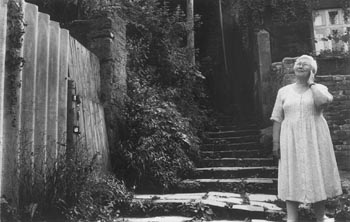![[Metroactive Movies]](/movies/gifs/movies468.gif)
[ Movies Index | Metro | Metroactive Central | Archives ]
The Inferno
Listening to the Past: Renée Firestone is one of the Holocaust survivors interviewed in the new documentary 'The Last Days.'
Forgotten corners of the Holocaust are explored in 'The Last Days'
THE SKY is blue, blue with that false Technicolor purity bestowed only on the clearest spring days in the country. Underneath that radiant sky, a few nude male figures walk away from the camera. They have been starved to the point that you can count their bones. The wings of their pelvises are just underneath their skin, sharp and painful. Their buttocks are wasted away. Their spines and ribs are as visible as the bones of a split-open fish. They shuffle away in unison. Someone with a camera told them to walk, and they walked. Why? To show that they could still walk?
In most images of the Holocaust, the graininess and blotches of inferior wartime film stock show like measles on the cadavers. The stony, dark-eyed faces look at us. Accustomed to the faces, we build up scar tissue. In the meanest, most hard-bitten souls, the faces of the camp evoke that despicably human feeling summed up by the old song from the trenches in World War I: "The bells of hell go ting-a-ling, a-ling, for you but not for me." The smuggled-out look of Holocaust films gives a nice safe distance, as if we were watching newsreels of the black plague. The footage of these starved men in The Last Days is clearer than most circulating prints of Gone With the Wind. Watching it, a switch snaps in the brain--there is no way to take comfort in historical distance. These last living witnesses interviewed by James Moll don't inhabit the past, but the present. They exist, the camps exist, it all really and truly happened.
Steven Spielberg produced Moll's documentary, and it's probably the biggest good deed Spielberg has ever done after a lifetime of striving. Moll has interviewed five different Hungarian survivors of the Holocaust, among them teacher Renée Firestone, businessman Bill Basch, grandmother Irene Zisblatt and Rep. Tom Lantos. But Moll also found a doctor from Auschwitz, exonerated by the war crimes board at Nuremburg but tellingly vague about his term there. Moll also interviews a sonderkommando, the liaison between the prisoners and the imprisoners. Moll's cameras link up the camps today with the camps as they were in full operation. The disorientation of sizes is elemental to the shock of the footage here. Seeing how crammed the prisoners were in the confines of Auschwitz, it's startling to see how big the place was--only aerial photographs can properly take in its size. It's disorienting to see the rusting rails to the camp overgrown with wildflowers, alive with butterflies and gilded grasshoppers, as inviting and summery as an abandoned rail spur in the Indiana fields. At Dachau, the ovens aren't much bigger than a medium-sized pottery kiln.
Some critics have tried to sugarcoat The Last Days by saying that the purpose of the film is to refute Holocaust deniers. On the contrary, the film isn't for them, it's for you. So few know the breadth and depth of the tragedy. Did you know that suicide wasn't really a way out? You might have thought, If I were there, I'd take the advice Job's friends gave him: I'd curse God and die. It wasn't quite that easy; the Nazis used to kill 100 prisoners in retaliation for every suicide in the camps. "Unfortunately, it is much, much worse than in the movies," says Congressman Lantos. The Last Days at least provides a glimpse of the unthinkable. It's equally unthinkable that some human beings could be strong enough to rise above this and live.
[ San Jose | Metroactive Central | Archives ]
![]()

Geoffrey Clifford
The Last Days (Unrated; 88 min.), directed by James Moll and photographed by Harris Done.
From the March 11-17, 1999 issue of Metro.